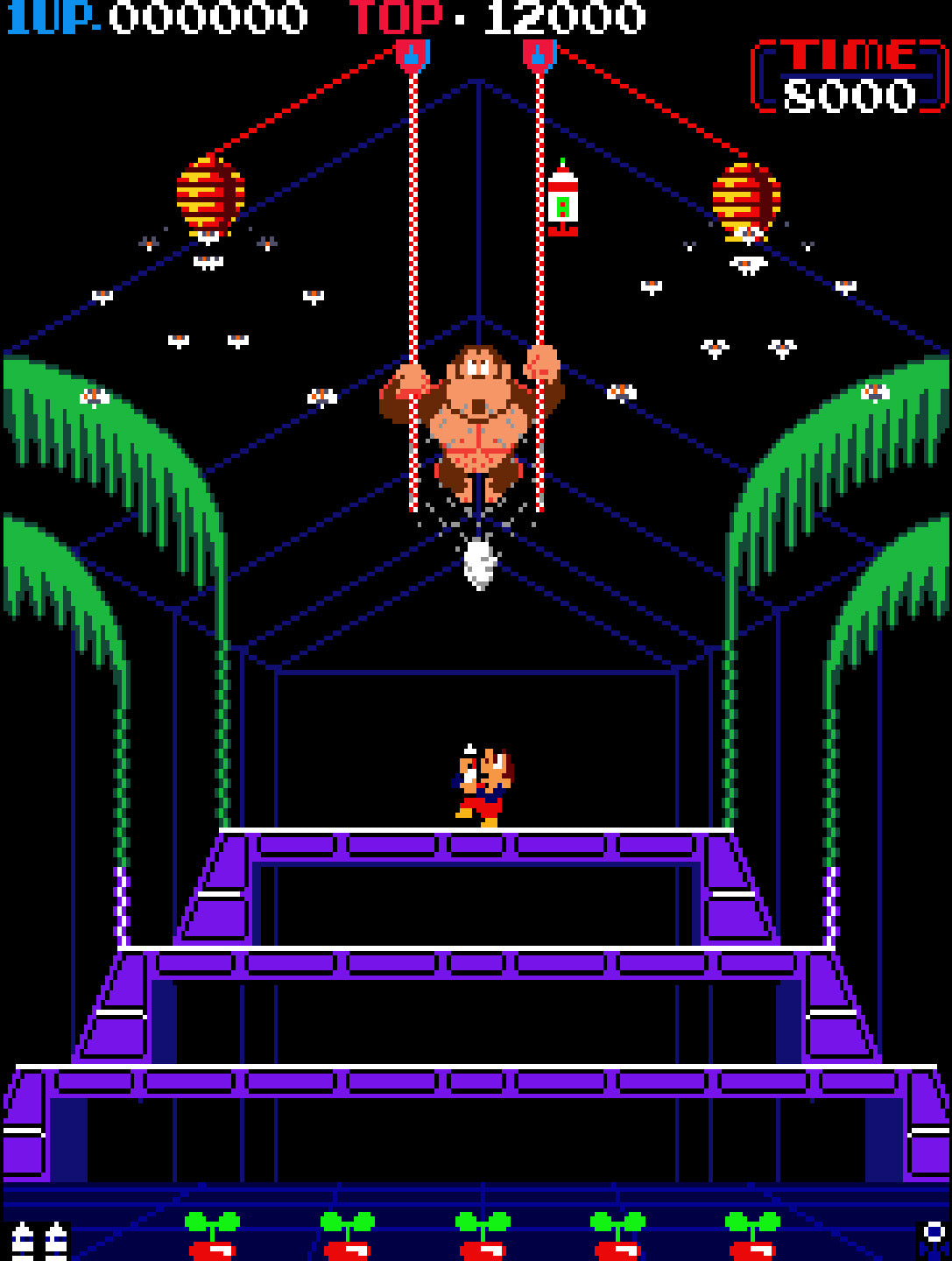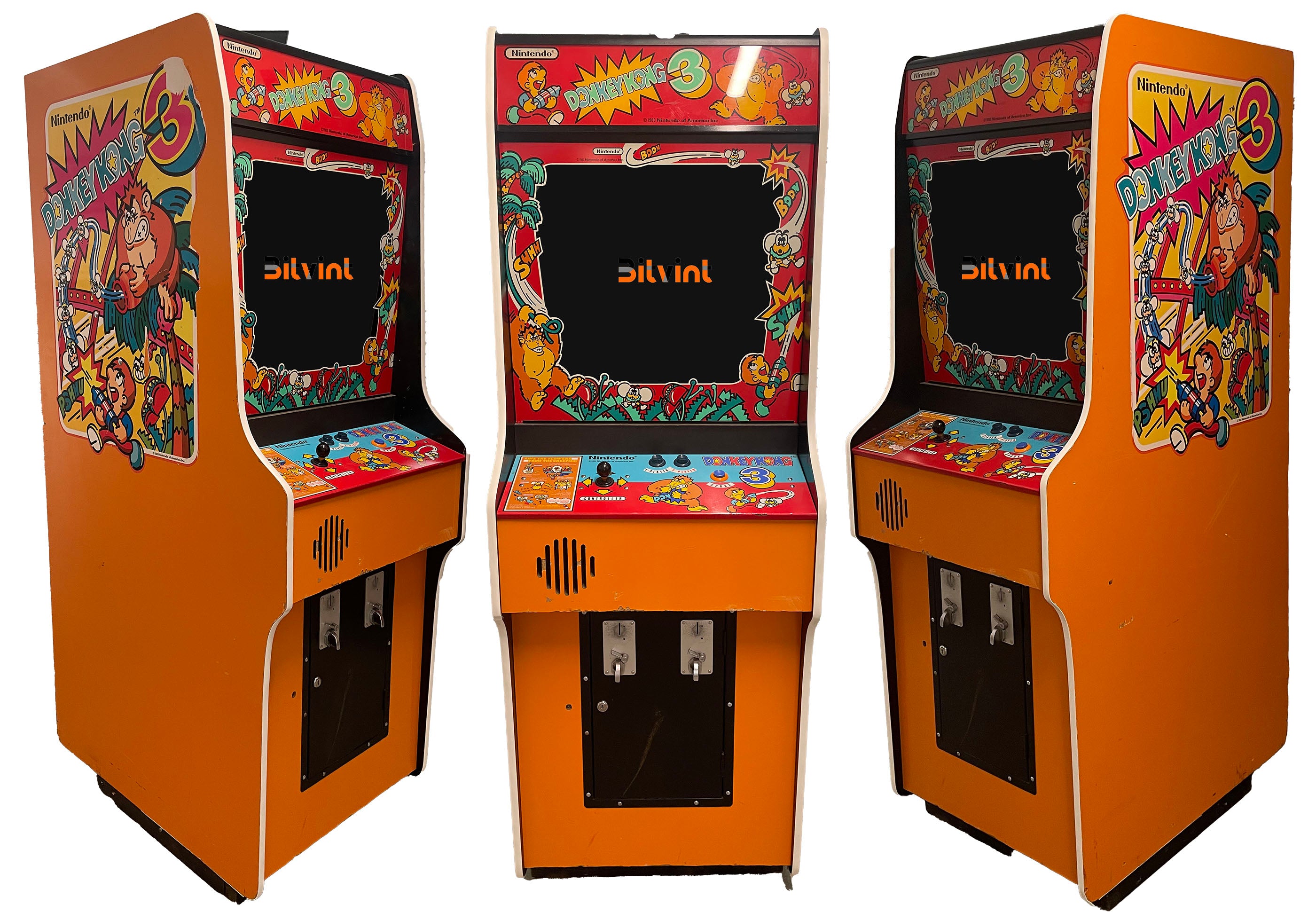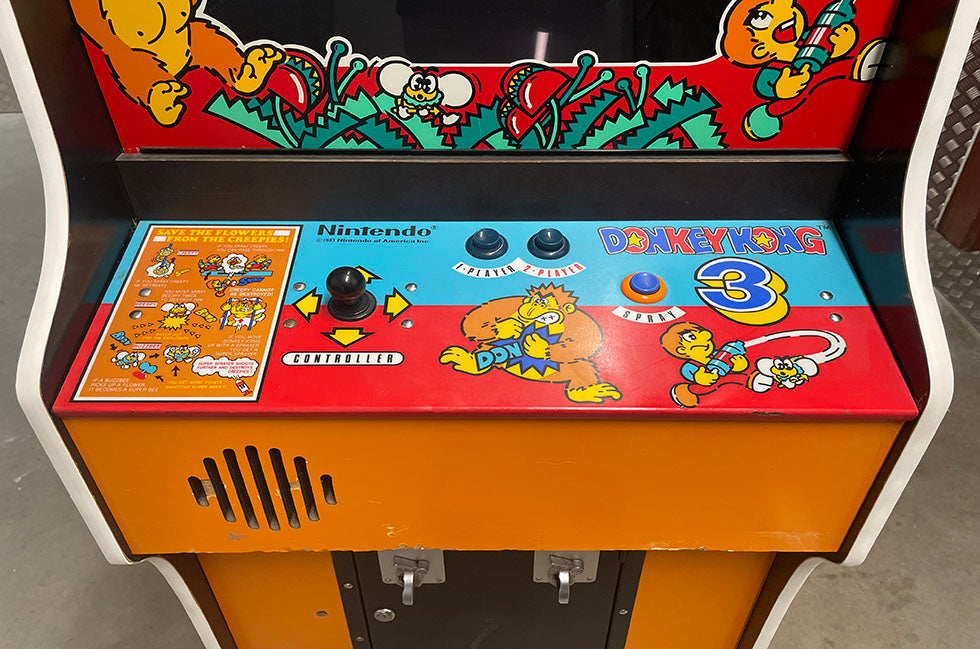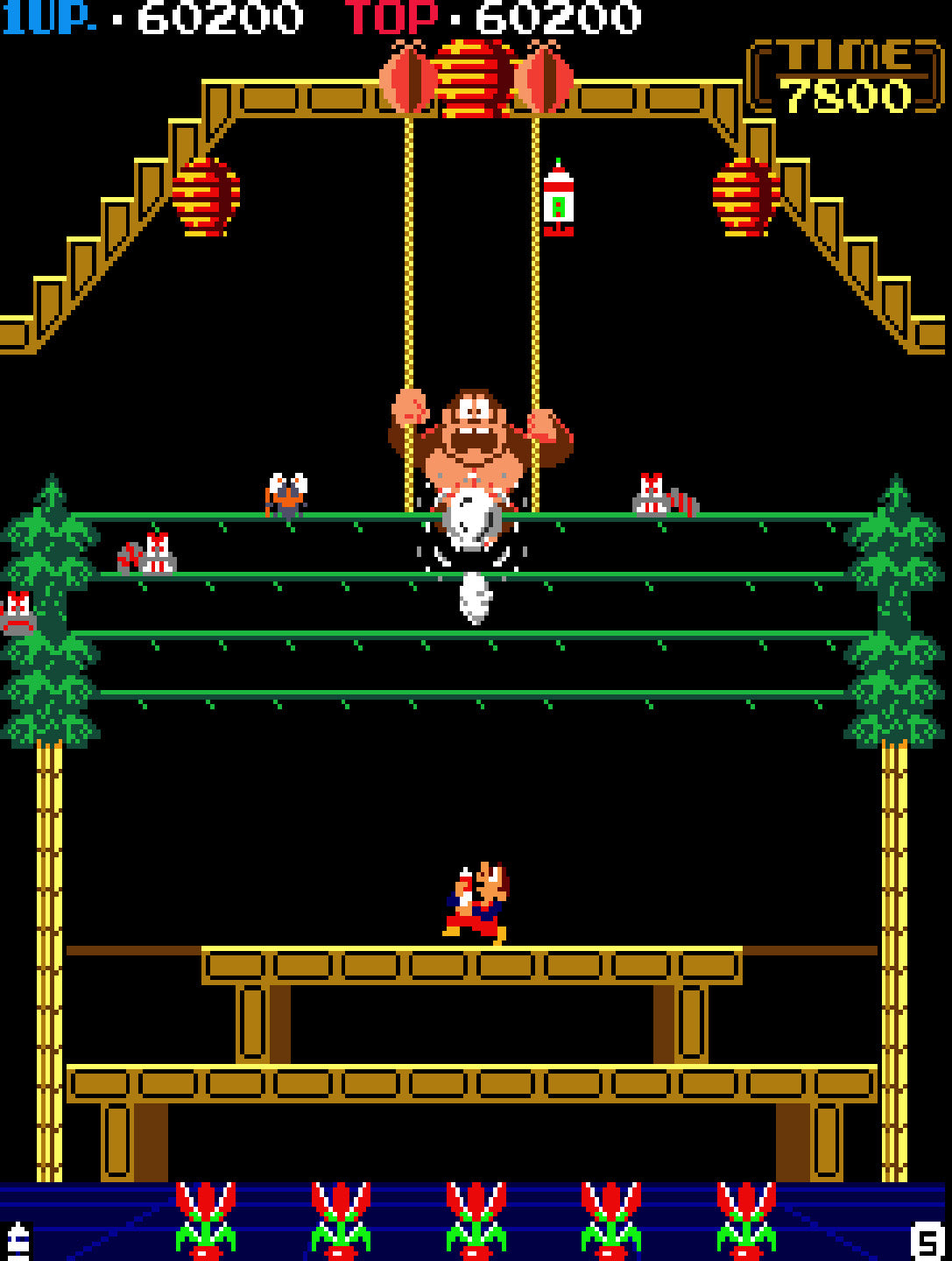Introduction
Donkey Kong 3 is the third installment in Nintendo’s groundbreaking Donkey Kong series. Released in 1983, this arcade game introduced new gameplay mechanics and a fresh protagonist, taking the series in an entirely new direction. While it deviated from the platforming style of its predecessors, Donkey Kong 3 carved its niche with action-packed shooting gameplay and remains a fascinating chapter in Nintendo’s history.

The History of Donkey Kong 3
Following the immense success of Donkey Kong (1981) and Donkey Kong Jr. (1982), Nintendo sought to innovate with the third entry in the series. Shigeru Miyamoto, who played a crucial role in the development of the previous titles, teamed up with Yukio Kaneoka and other developers to create a game that pushed boundaries while retaining the charm of the Donkey Kong franchise.
Key Facts:
- Release Year: 1983
- Developer: Nintendo
- Designer: Shigeru Miyamoto and Yukio Kaneoka
- Platform: Arcade cabinets, later ported to the NES and other home consoles

History of Donkey Kong 3 Video
Gameplay and Objectives
In Donkey Kong 3, players control Stanley, an exterminator tasked with protecting his greenhouse from Donkey Kong and a swarm of insects. The gameplay shifts from platforming to a vertical shooting style, creating a unique experience within the series.
Gameplay Features:
- Core Objective: Prevent Donkey Kong from climbing down vines and disrupting Stanley’s greenhouse while eliminating waves of insects.
- Weapons: Stanley uses a bug spray to repel insects and Donkey Kong. Upgrades include a more powerful spray, adding variety to the combat.
- Stages: Levels become progressively harder, introducing more challenging enemy patterns and faster-paced gameplay.
Tip for Players: Focus on upgrading your spray weapon early and prioritize enemies that directly threaten your plants.

Donkey Kong 3 - Levels
"Donkey Kong 3" features a dynamic progression of levels, each presenting players with unique challenges and increasing difficulty. With a departure from traditional platforming, the game introduces a refreshing shooter-style gameplay that keeps players engaged and strategizing at every turn.
Stage 1 - The Greenhouse:
The game opens in Stanley's greenhouse, where players must fend off waves of insects threatening his precious plants. This introductory level serves as a tutorial, familiarizing players with the controls and mechanics of spraying bugs while avoiding their attacks.
Stage 2 - The Treehouse:
In the second stage, the action shifts to Donkey Kong's treehouse. Here, players face an escalating swarm of insects and Donkey Kong himself, who attempts to push them down onto Stanley. Strategy becomes key as players navigate platforms, use the environment, and manage their bug spray to counter the dual threat.
Stage 3 - The Apiary:
The third stage takes place in an apiary, introducing new challenges as players combat bees and their queen. Players must clear the hives while dealing with bees that aggressively pursue them. This stage demands quick reflexes and precise aiming to prevent the bees' onslaught.
Stage 4 - The Cave:
The final stage brings players to a cave where the ultimate showdown with Donkey Kong awaits. This level ramps up the difficulty significantly, requiring players to focus on hitting Donkey Kong while managing the onslaught of insects. Timing and accuracy become critical as players strive to emerge victorious.
Unique Features and Innovations
Donkey Kong 3 stood out for its bold departure from the gameplay style of its predecessors. It was an early attempt by Nintendo to diversify its arcade offerings.
Key Innovations:
- New Protagonist: Stanley the Bugman replaced Mario as the player character, offering a fresh perspective and storyline.
- Hybrid Gameplay: Combining shooting mechanics with light puzzle elements made the game distinct within the series.
- Dynamic Difficulty: The increasing speed and aggression of enemies ensured a challenging experience that kept players coming back.
Strategies for High Scores
- Protect the Plants: Bonus points are awarded for plants that remain untouched, so focus on defending them while battling Donkey Kong and the insects.
- Use the Environment: The layout of vines and platforms can be used to funnel enemies and target them more effectively.
- Prioritize Upgrades: Collect power-ups to maximize your bug spray's effectiveness, especially in later levels where enemies become faster and more numerous.

Stanley the Bugman: The Unconventional Hero of Donkey Kong 3
In the classic arcade game "Donkey Kong 3," players assume the role of Stanley the Bugman, an unconventional hero tasked with protecting his greenhouse from the antics of Donkey Kong and a swarm of troublesome insects. Unlike the previous "Donkey Kong" games, where Mario took center stage, Stanley brings a fresh perspective to the series.
Stanley's weapon of choice is a can of bug spray, used to fend off both Donkey Kong and the insects threatening his plants. As players guide Stanley through various stages, they must master his precise movements and accurate spraying to repel the adversaries. Stanley's unique role as a greenhouse owner turned unlikely hero adds a distinctive twist to the game's narrative and gameplay, showcasing Nintendo's willingness to experiment with characters and mechanics within established franchises.
Legacy and Player Reception
Donkey Kong 3 received a mixed reception upon release. While praised for its originality, some fans missed the platforming mechanics that defined the earlier games. Over time, the game has gained appreciation for its unique contributions to the franchise.
Community Feedback:
- Players Appreciate: The fast-paced action and quirky, lighthearted premise.
- Critics Note: The absence of Mario and the shift in gameplay divided fans but also highlighted Nintendo’s experimental spirit.
Modern Legacy: Donkey Kong 3 has become a cult classic among retro gaming enthusiasts and is often revisited in Nintendo’s game collections, preserving its place in gaming history.

Fun Facts
- Stanley’s Cameo: Stanley the Bugman made a rare appearance in Super Smash Bros. Melee as a collectible trophy.
- Limited Sequels: Unlike Mario and Donkey Kong, Stanley never became a recurring character in Nintendo’s lineup, making Donkey Kong 3 a unique outlier.
- Cross-Genre Innovation: The shooting mechanics in Donkey Kong 3 influenced other Nintendo titles, showcasing their versatility in game design.

Conclusion
Donkey Kong 3 may not have reached the legendary status of its predecessors, but its unique gameplay, charming visuals, and bold experimentation make it a fascinating entry in the Donkey Kong series. It’s a reminder of Nintendo’s willingness to innovate and push boundaries, creating games that stand out even decades later. Whether you’re a longtime fan or new to the franchise, Donkey Kong 3 offers a fun and distinctive arcade experience.
Explore More:
Interested in other Donkey Kong games? Check out our guides on Donkey Kong (1981) and Donkey Kong Jr. (1982) to see how the series evolved over time.
Questions you might have:
What is the gameplay like in "Donkey Kong 3" arcade?
"Donkey Kong 3" features shooter-style gameplay where players control Stanley the Bugman. Using a bug spray, players repel insects and Donkey Kong, who moves along vines. The goal is to protect plants from insects and keep Donkey Kong at bay.
Who are the main characters in the game?
The main character is Stanley the Bugman, a greenhouse owner. Donkey Kong appears as the antagonist, and insects like bees and beetles serve as enemies.
How does "Donkey Kong 3" differ from the previous "Donkey Kong" games?
Unlike previous "Donkey Kong" games, "Donkey Kong 3" abandons platforming for a shooter mechanic. It shifts focus from jumping to strategic shooting to protect plants from insects and Donkey Kong.
What are the different stages and levels in the game?
The game consists of four stages, each with increasing difficulty. Players progress through the greenhouse, treehouse, apiary, and a final cave level.
Is "Donkey Kong 3" a shooter-style game?
Yes, "Donkey Kong 3" is a shooter-style game, where players use Stanley's bug spray to fend off enemies rather than traditional platforming.
What are some of the enemies and challenges players face?
Players face various insects like bees and beetles, each with unique behaviors. Donkey Kong's movement patterns and attempts to dislodge insects onto Stanley create dynamic challenges.
Can I play "Donkey Kong 3" on modern platforms?
"Donkey Kong 3" is available on various retro game collections and arcade emulation platforms, allowing players to experience it on modern systems.
Are there any unique mechanics or power-ups in the game?
The main mechanic is Stanley's bug spray, but there are no traditional power-ups. Players must focus on timing, accuracy, and strategic positioning.

